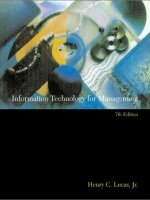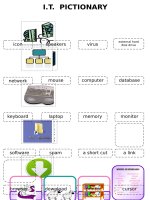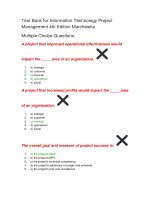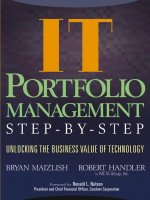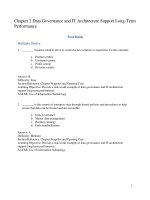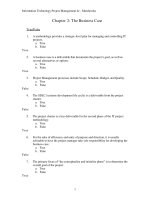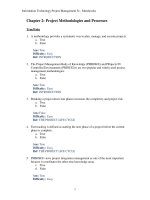IT information technology portfolio management step by step by bryan maizlish robert handler
Bạn đang xem bản rút gọn của tài liệu. Xem và tải ngay bản đầy đủ của tài liệu tại đây (5.53 MB, 401 trang )
IT
Portfolio
Management
Step-by-Step
Unlocking the Business Value
of Technology
Bryan Maizlish
and
Robert Handler
(for the META Group, Inc.)
John Wiley & Sons, Inc.
IT
Portfolio
Management
Step-by-Step
IT
Portfolio
Management
Step-by-Step
Unlocking the Business Value
of Technology
Bryan Maizlish
and
Robert Handler
(for the META Group, Inc.)
John Wiley & Sons, Inc.
This book is printed on acid-free paper.
Copyright © 2005 by Bryan Maizlish and META Group, Inc. All rights reserved.
Published by John Wiley & Sons, Inc., Hoboken, New Jersey.
Published simultaneously in Canada.
No part of this publication may be reproduced, stored in a retrieval system, or transmitted
in any form or by any means, electronic, mechanical, photocopying, recording, scanning,
or otherwise, except as permitted under Section 107 or 108 of the 1976 United States
Copyright Act, without either the prior written permission of the Publisher, or authorization
through payment of the appropriate per-copy fee to the Copyright Clearance Center, Inc.,
222 Rosewood Drive, Danvers, MA 01923, 978-750-8400, fax 978-646-8600, or on the web
at www.copyright.com. Requests to the Publisher for permission should be addressed to the
Permissions Department, John Wiley & Sons, Inc., 111 River Street, Hoboken, NJ 07030,
201-748-6011, fax 201-748-6008.
Limit of Liability/Disclaimer of Warranty: While the publisher and author have used their
best efforts in preparing this book, they make no representations or warranties with respect
to the accuracy or completeness of the contents of this book and specifically disclaim any
implied warranties of merchantability or fitness for a particular purpose. No warranty may
be created or extended by sales representatives or written sales materials. The advice and
strategies contained herein may not be suitable for your situation. You should consult with a
professional where appropriate. Neither the publisher nor author shall be liable for any loss
of profit or any other commercial damages, including but not limited to special, incidental,
consequential, or other damages.
NOTE TO THE READER: Unless otherwise noted, all of the studies (including percentages
shown), and exhibits that appear in the book were either adapted from or are the original
material copyrighted to META Group, Inc.
For general information on our other products and services, or technical support, please
contact our Customer Care Department within the United States at 800-762-2974, outside
the United States at 317-572-3993 or fax 317-572-4002.
Wiley also publishes its books in a variety of electronic formats. Some content that appears in
print may not be available in electronic books.
For more information about Wiley products, visit our web site at www.wiley.com.
Library of Congress Cataloging-in-Publication Data:
Maizlish, Bryan.
IT portfolio management step-by-step: unlocking the business value of technology /
Bryan Maizlish and Robert Handler.
p. cm.
ISBN-13 978-0-471-64984-8 (cloth)
ISBN-10 0-471-64984-8 (cloth)
1. Information technology—Management. 2. Information technology—Cost
effectiveness. I. Handler, Robert. II. Title.
HD30.2.M346 2005
004'.068'1—dc22
2004024583
Printed in the United States of America
10 9 8 7 6 5 4 3 2 1
To my wife Robin, the love of my life, my best friend, and the voice
of sanity and reason in our household—thank you for your unconditional support and providing the unwavering encouragement, confidence, and inspiration to write this book and achieve my dreams.
Thank you to my children Jennifer, Evan, and Emily for bringing joy
and happiness into my life, for your incredible patience in this journey,
and for your wisdom and counsel in helping me keep things in perspective. And, thank you to my mother, Sondra, for your wonderful
advice throughout the journey.
Bryan Maizlish
Words cannot express the appreciation I have for my wife, Jennifer, my
son, Charles, my daughter, Alexis, my two golden retrievers, and many
others. The effort required to create this book took me away from
them more than I had anticipated, yet they stood by me. Thank you
also to my parents, David and Claire, who, via nature or nurture, gave
me the fortitude to complete this project. It is to all my loved ones who
supported me in life that I dedicate this book.
Robert Handler
Acknowledgments
IT Portfolio Management Step-by-Step: Unlocking the Business Value of Technology
is the result of 15 years of effort, beginning with our research on financial portfolio management and branching out to information technology (IT) portfolio
management. The content in this book was shaped and sculpted based on the
stellar research from META Group, Inc., studies from academia, collaboration
with IT portfolio management software providers and consultants, and input
and feedback from leading practitioners. Thank you for your support, encouragement, and counseling.
There are a few key individuals who deserve special mention. Without the
steadfast support of Richard Buchanan, CD Hobbs, Val Sribar, and Dale Kutnick,
and their willingness to allow us utilize resources and key personnel, this book
would have not succeeded. Also, a profound thank you to Mike Thomas, Roland
Wiltz, and Roger Mann, for providing a foundation that supported our inspiration and creativity. We are deeply grateful to these individuals for allowing us to
follow our passion.
We are very appreciative and truly humbled by the generous contributions
made by the analysts at META Group. Their tremendous talent, intellect, professionalism, and in-depth research and knowledge provided both content and spirit
to our book. Many of these individuals supported our efforts on their own time.
Thank you very much for your time, research, and perspectives. Their names,
listed below as contributing authors to this book, are as follows (in alphabetical
order):
viii
acknowledgments
Phil Allega
Wille Appel
Melinda-Carol Ballou
Andreas Bitterer
Scott Bittler
Louis Boyle
Richard Buchanan
Michael Buchheim
Brian Burke
Enrico Camerinelli
David Cearley
Michael Doane
CD Hobbs
Dale Kutnick
Carole McPherson
George Paras
Al Passori
Jonathan Poe
Wissam Raffoul
Elizabeth Roche
Dr. Howard Rubin
Val Sribar
Tim Westbrock
Barry Wilderman
A special thank you to both Michael Booker and Dr. Peter A. Koen. Michael
Booker from Stage-Gate, Inc. provided insight and support for the Stage-Gate®
processes discussed in our book. Dr. Peter A. Koen, Associate Professor at The
Wesley J. Howe School of Technology Management, Stevens Institute of Technology provided valuable input to the discovery phase or “fuzzy front end of
innovation” sections of our book.
There were also many important contributions made by other individuals that
we would like to thank (in alphabetical order): Shawn Bohner, Brad Boston
(Cisco Systems Inc.), Michael Carlson (Xcel Energy), Casey Chaloux, Kim Cook
(In-Q-Tel), Dennis Crowley (Cutter Consortium), Martin Curley (Intel Corporation), Matt Dezee (Cisco Systems Inc.), Vince DiGennaro, Don DiNunno,
Sabina Gargiulo (Institute for International Research), Ray Gogel (Xcel Energy),
Mike Gruia (United Management Technologies), Ian S. Hayes (Clarity Consulting), Brian James (Mercury Interactive), Doug Laney, Rick Laubscher, Kevin
Laughlin (Cisco Systems, Inc.), Harry Lee (The Department of Treasury), David
Lindheimer, Gilman Louie (In-Q-Tel), Doug Lynn, David Perko (Teradyne Inc.),
Dave Peterson (Mercury Interactive), Rachel Quercia (Pacific Edge Software),
Sue Reber (ProSight, Inc.), John Reece (John C. Reece & Associates), Marnie
Ross, Terry Ross (Pacific Edge Software), Karen Rubenstrunk, Jane Seago (IT
Governance Institute), Michael Slovin, Mitch Taylor (Cisco Systems, Inc.), Rick
Turoczy (ProSight Inc.), Herb VanHook, Kris van Riper (Corporate Executive
Board/CIO Executive Board), Katherine Vogt (Corporate Executive Board/CIO
Executive Board), Gayle von Eckartsberg (In-Q-Tel), Dr. Sami Zahran (IBM),
and Aaron Zornes.
We would like to thank Suzanne (Meier) Dvorchak for balancing her family
life and the editing needs of this book. Her insight, suggestions, and pragmatic
approach helped bring many concepts together. Also, special thanks to Barbara
Koning, who went into overdrive in providing many of the graphics. Thank you
for your personal attention and collaborative support.
acknowledgments
ix
We are very appreciative toward Ron Nelson for taking time out of his busy
schedule to write the outstanding Foreword to our book.
Our editor, Tim Burgard, and editorial support from Helen Cho and Kim Nir
deserve special praise for supporting this book, teaching us the art and science of
the English language, and tolerating our often strong opinions. Thank you for seeing the value of IT portfolio management, and for guiding us through the publishing process.
We should note that as this manuscript went to press, META Group had agreed
to be acquired by Gartner, Inc. The merger was expected to be completed early
in the second quarter of 2005, approximately when IT Portfolio Management was
scheduled to be published.
We are also deeply grateful to our families who endured the long hours and
collaboration that went into this book and supported us all along the way. To
Robin Maizlish and Jennifer Handler, our heartfelt love and gratitude cannot be
expressed with words. Through it all, we built a strong and enduring friendship.
Also great thanks to our children who were remarkably understanding of the
time and commitment it took to write this book. Thank you Alexis Handler,
Charles Handler, Jennifer Maizlish, Evan Maizlish, and Emily Maizlish. You kids
rock!
Most of all we’d like to thank you, the reader, for supporting this effort. We
have deep respect for you, the change agents, who must do one of the most difficult things there is to do—exercise positive change in the face of often extreme
resistance. We did our best to put together something that was useful to the
change agents, providing context, a usable approach, and lessons learned, but we
know that effecting positive change in any organization is usually no small task.
Thank you.
Foreword
In the information age, knowledge provides a competitive edge that no business
can ignore. The challenge, however, is that with all of the hype, complexity, and
confusion around information technology (not to mention a healthy dose of
jargon) it is often difficult to distinguish between good and bad technology
investments. That’s problematic, or at least it should be, because information
technology is the central nervous system of most organizations, providing the
tools to act rapidly to changes in the business environment. If the information
technology is optimized, the organization can thrive, even in the most chaotic
times. Optimizing information technology investments is not an option—it is a
business mandate.
Information technology investments currently account for the majority of capital expenditures within many companies; therefore it must be treated with at least
the same due diligence rigor as any other capital investments. A sound business case
must exist; it must support the strategy of the organization; and it must support, and
in many ways adhere to, new legislation.
We are increasingly expected to provide accurate information to multiple
shareholder and stakeholder groups at light speed. But that should not be a justification for throwing caution to the wind and spending whatever it takes to
accomplish that goal. Like any other investment, information technology must be
actively managed throughout its entire life cycle, ensuring that both its initial and
ongoing costs do not exceed the benefits it provides. We cannot afford to treat
investments in information technology as unmanaged operating expenses, as they
provide far too many opportunities for value creation, cost savings, and relevant,
xii
foreword
timely, and accurate information that serve as seminal elements of competitive
advantage.
IT portfolio management provides a sound and proven business approach to
optimizing investments in information technology. The investment portfolio
metaphor provides a mechanism to govern investments in information technology that accounts for their value, risks, costs, useful life, and interrelationships.
Much the way an investment manager dynamically manages a portfolio of financial investments, business leaders must make intelligent buy, sell, and hold decisions around their investments in information technology to optimize revenue
and growth opportunities, improve customer experience, and streamline operations; when done properly, the productivity improvements and cost savings that
result will positively impact the bottom line and allow us to fulfill our primary
obligation: driving shareholder value. For example, automated transaction processing through online order making and order taking has created opportunities
to offer complex services through dynamically packaging new customized offerings, generating additional fees, and better meeting the customer needs of a
global audience. The online travel business is a good example of how information technology has served as a powerful enabler, facilitating streamlined fee-forservice and inventory management models, and providing greater access to
published air, car, cruise, and hotel fares, and travel packages worldwide for both
leisure and business travelers.
With the growing investment in information technology and the profound
contribution of information technology within many companies, it is imperative
that the interactions between risk, reward, and value for information technology
investments are proactively identified, evaluated, prioritized, and managed. IT
Portfolio Management makes this case strongly and logically, providing evidence and
case studies to support this argument. IT Portfolio Management highlights the
impact of adopting this technique, from organizational change to governance
impacts down to the bottom line. Many books present approaches to effecting
positive business change, but IT Portfolio Management presents the approach and
provides the steps required to transform an organization from ad hoc information
technology management to information technology optimization, replete with
lessons learned. IT Portfolio Management is not a revolutionary approach. It is an
evolutionary approach that works. The authors thoughtfully provide tools to
measure your organization’s abilities and to help it evolve over time to information technology excellence.
Following the guidance of this book, organizations can evolve into adaptive
real-time enterprises that thrive in a world of change. IT Portfolio Management
provides an answer to every senior business leader’s questions around the black
hole of the IT budget. IT Portfolio Management also provides answers to how IT
foreword
xiii
professionals should breakdown the barriers and effectively communicate with
business leaders in their language. Maintaining a strong balance sheet, alignment
of assets, occupying and sustaining a leadership position, and achieving profitable
and relevant return on investments cannot be separated from sound practices of IT
portfolio management, and are the fiduciary responsibilities of leaders in an information technology era.
Ronald L. Nelson
President and Chief Financial Officer
Cendant Corporation
Overview of the Book
IT Portfolio Management:
An Overview
Chapter 1
Introduction
Part I
Introduction
and
Background
Considerations in Building & Maintaining an IT Portfolio
Planning for IT Portfolio
Management: Ready,
AIM, THEN Fire
Chapter 2
People and Governance:
The Most
Important Success
Factors of IT Portfolio
Management
Chapter 3
IT Portfolios and
Their Content in
Context
Chapter 4
Part III
Building: Stepby-Step
Building the IT Portfolio
Chapter 5
Considerations in Choosing the Right Tool and Detailed Insights
The IT Portfolio
Management Market
and Industry Provider
Assessment Methodology
Chapter 6
Final Thoughts
Chapter 7
Part II
Foundational
Elements
Case Studies
and
Other Detailed
Information
Appendices
Part IV
Implementing,
Conclusion,
and
Detailed
Best
Practices
Part I: Introduction and Background
The Introduction provides the readers with a brief overview of IT portfolio management and a description of what lies ahead. It sets the stage for readers who are
new to IT portfolio management. Experienced readers should skim this section.
Chapter 1, IT Portfolio Management: An Overview, provides the foundation
building for the remainder of the book. For readers who are new to IT portfolio
xvi
overview of the book
management, Chapter 1 provides a good overview with a description of the definitions and characteristics, and a discussion on the value and risk associated with
IT investments. For readers who are experienced at IT portfolio management, we
recommend skimming through this chapter.
Part II: Foundational Elements
Chapter 2, Planning for IT Portfolio Management: Ready, Aim, THEN Fire, provides a description of some of the assessments and readiness dimensions related to
IT portfolio management. Readers who are new to IT portfolio management
should carefully read this section. For experienced readers, we suggest, at a minimum. skimming this section. This chapter touches upon many of the organizational relationships that are often missed by even experienced practitioners, so it is
definitely worth the time to read this chapter. Chapter 2 also provides important
insight with respect to the IT portfolio management maturity model. We recommend that all readers focus on this section of the chapter. Balance and alignment
across the elements of the maturity model is critical to optimize one’s performance.
Chapter 3, People and Governance: The Most Important Success Factors of IT
Portfolio Management, describes how regulatory changes are affecting management’s approach to monitoring, controlling, and responsible risk-taking. The Sarbanes-Oxley Act and other compliance requirements are driving a focus on
governance, and the associated policies and principles. For readers who are new to
governance, we suggest reading this chapter. For readers who have efficient and
effective governance structures in place, we advise skimming this chapter.
Chapter 4, IT Portfolios and Their Content in Context, describes the linkage
between the IT life cycle phases and the three IT portfolios. In addition, detailed
information is provided regarding the structure and content of each portfolio. For
readers who are new to IT portfolio management, we suggest skimming this
chapter and referring back to it on a frequent basis. There are many areas within
Chapter 4 that cross over to Chapter 5. For readers who are experienced at IT
portfolio management, Chapter 4 provides examples of how other companies
approach this subject, and therefore should be read in depth.
Part III: Building: Step-by-Step
Chapter 5, Building the IT Portfolio, discusses in detail the eight key stages
in building the IT portfolio. This is the longest chapter, and, for most readers,
will represent the most important material in this book. Each stage, and its
overview of the book
xvii
sub-elements (e.g., tasks, outputs, and skill requirements), are shown along with
images to illustrate the steps and processes. While Part I and Part II provide important foundational elements, readers, both novice and experts, are encouraged to
focus on the valuable and extensive information provided in this chapter.
Part IV: Implementing, Conclusion, and Detailed Best Practices
Chapter 6, The IT Portfolio Management Market and Industry Provider Assessment Methodology, discusses the current and future state of the IT portfolio management software marketplace, and provides a comprehensive industry provider
assessment methodology. Functional capabilities, presence, and performance criteria form many of the critical decision factors companies should consider in evaluating and selecting an IT portfolio management tool. This chapter targets
information for readers at all levels.
Chapter 7, Final Thoughts, summarizes many of the important points raised in
this book. The future vision of adaptive technologies, the impact of legislation,
and other factors are brought forward for consideration. This chapter, although
optional, helps to put it all in perspective.
The Appendixes provide detailed case studies from three exemplar companies—Cisco Systems, Inc., In-Q-Tel, and Xcel Energy. Many of the core principles and process are illustrated in these case studies. Readers will find these case
studies very illuminating.
Contents
foreword
overview of the book
introduction
chapter 1
IT Portfolio Management: An Overview
Cha Cha Changes in the Current Environment
Focus on IT Investments
Forming, Norming, Storming: The IT Life Cycle
Does IT Really Matter? The IT Productivity Paradox
IT Portfolio Management 101
Comparison of IT Portfolio Management and
Financial Portfolio Management
Value and Risks
Conclusion
Appendix 1A: Selected Firm-Level Studies
of IT Returns
chapter 2
xi
xv
1
7
7
8
13
14
17
27
28
33
36
Planning for IT Portfolio Management: Ready, Aim,
THEN Fire
39
Introduction
Baseline Assessments
Organization Readiness
IT Portfolio Management Maturity
IT Portfolio Management Capability Assessment
Stakeholder Analysis
39
41
42
42
46
47
xx
contents
Refining IT Portfolio Objectives
Portfolio Metrics
Chartering the Effort
Task Planning
Communication Planning
IT Portfolio Management Software Selection
Conclusion
Appendix 2A: IT Portfolio Management Maturity Levels
chapter 3
People and Governance: The Most Important Success
Factors of IT Portfolio Management
Introduction
A Demanding Environment
The New Focus for IT: Business
The Business–IT Alignment
IT Governance
CobiT: Managing the Risk and Control of IT
Getting Started
Appendix 3A: Sarbanes-Oxley Compliance Road Map
Appendix 3B: Top Issues Faced by Management
Appendix 3C: Top Issues Mapped to Key Individuals
and Governance Bodies
chapter 4
chapter 5
49
53
54
55
55
57
58
59
65
65
67
71
80
81
91
92
97
99
102
IT Portfolios and Their Content in Context
107
Introduction
IT Discovery Portfolio
IT Project Portfolio
IT Asset Portfolio
Conclusion
Appendix 4A: Technology Readiness Levels:
Hardware and Software
107
121
128
142
168
171
Building the IT Portfolio
175
Introduction
Stage 1: Game Plan
Stage 2: Planning
Stage 3: Creating
Stage 4: Assessing
Stage 5: Balancing
Stage 6: Communicating
175
185
202
211
234
246
260
contents
Stage 7: Governance and Organization
Stage 8: Assessing Execution
Conclusion
Appendix 5A Value Categories and Value Factors
Appendix 5B Risk Categories and Risk Factors
Appendix 5C Readiness Assessment: Business,
Internal, and Operational Diagnostics
chapter 6
The IT Portfolio Management Market and Industry
Provider Assessment Methodology
Introduction
IT Portfolio Software Market
IT Portfolio Software Selection Process
Industry Provider Assessment Methodology
Conclusion
Appendix 6A Advanced IT Portfolio Software Provider
Evaluation Criteria
chapter 7
xxi
266
270
274
276
278
280
285
285
286
289
292
303
304
Final Thoughts
321
The Future Vision
326
case studies
329
index
367
